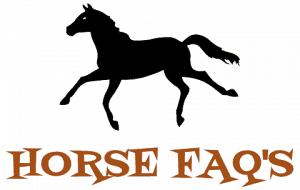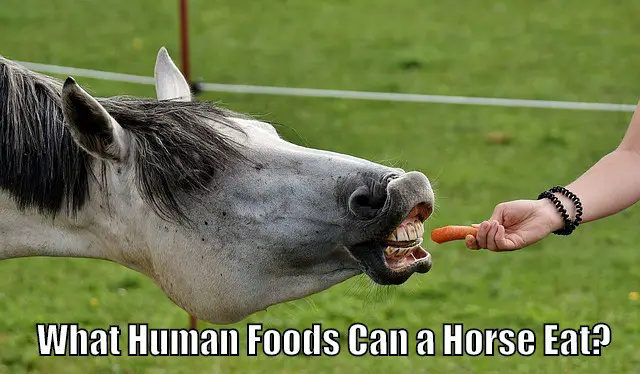What Human Foods Can a Horse Eat?
Well, it has been known for hundreds of years that horses eat grasses, leaves, hays or anything green that is very edible on the ground. But have you ever imagined these grass-eating animal feasts over freshly-cooked salmon, over a sumptuous dinner from a famous resto in the west, or eating a huge bowl of salad with homemade vinaigrette—just like how you do?
Would you believe if I say that they can actually eat like us, humans? In fact, they’ve got these diet meals that are way beyond these grassy stuff that we know really. To give you some new and fun ideas about these new horse’s diet meals, I have created here a list of human foods that you can actually explore with and can be added to your horse’s daily meals.
So what are these human foods that can a horse eat? Knowing that horses are herbivores and that they acquire this kind of unique type of digestive system, they can eat some human foods that are really safe for their stomachs. This could be on a variety of succulent fruits like apple, watermelon, plum, orange, peach, pear, coconut, grapefruit, even carrots and bananas with peel that is found to be a good source of fibre which is basically needed by horses for good digestion. Other human foods can also be given to horses as treats (or foods for special occasions) in a moderate amount as long as it will not cause them poisoning and that they can fully take the food and absorb it via their distinct digestive tract.
What can we give to horses as treats?
Talking about human foods here, I’m pretty sure that you have already asked yourselves if these horses can also eat meaty foods and even processed foods like sausages, canned goods, crisps and chips. Don’t be surprised but the answer is yes! Horses can eat these kind of foods but these must be cut into smaller pieces or super bitesize. Why? Simply because horses have a quite long yet narrow esophagus and they have this little capacity to do reflux hence, more prone to choking when food is not being properly chewed by them. Also, horse’s teeth are designed for grass-like foods or any plants therefore, making it hard for them to chew meat and the like so it is really advisable to cut-down those treats into smaller pieces so it will be easier for them to chew the food. For them to fully enjoy their treats, make sure that could be able to eat those foods thoroughly.
Aside from these treats for your horses, you can also let them have some cereals, normal grains, sunflower seeds, peppermints, raisins and sugar cubes as their rewards when training or simply you just want them to have some good food sometimes. Who doesn’t love treats, anyway?
However, treats should be actually minimized and should also be considered as one of the contributors of entire feeding plan of the said animal for these also can add up to its total weight that can basically affect the whole function or physiology of your horse. You must really take note of your horse’s health and physique most especially if you are competing your horse and needed to undergo weight counting.
What are the human foods that are not safe for them to eat?
The mentioned food above are those human foods that can be eaten by horses and are also safe for them to consume. On the other shade, there are also human foods that can be actually eaten by horses but considered HARMFUL for their health and are not advisable to mix or add into horses’ feedings. These kind of foods are:
- Any food or drink that has caffeine (whether a main component or not). Examples of these are coffee, tea, and sodas. Caffeine can also affect horse’s heart by altering its pumping processes. This might also cause some serious cardiologic problems to horses.
- Chocolate products. Theobromine is their main content which is harmful to animals, not only horses, but also to cats and dogs. This type of alkaloid can cause mild to serious complications to horses by means of theobromine poisoning. Upon intake of too much theobromine in an animal body, effects in metabolic processes might be evident such as dehydration and excitability of the animal. If not treated, theobromine can cause seizures to animals, to your horses, that might lead to death.
- Garlic and onions. These two mainly are members of the Allium family alongside with leeks, chives as well as scallions. These species of Allium possess this chemically based component called N-propyl disulphide that can cause an animal toxicosis. At first, horses might experience some loss of appetite, depression and dehydration but after few days of absorption, horses as well as other animals will slowly show signs of loss of RBCs (red blood cells). These signs can be: secretion of pale mucous membranes, increased rate of breathing, lethargy, jaundice and dark-colored urine.
- Tomatoes for they contain atropine and hyoscyamine. The atropine present on the leaves of tomatoes can cause colic by slowing horses’ gut function while the hyoscyamine that is present in tomatoes can lower the amount of saliva being produced by the animal. Also, hyoscyamine can increase heart rate and can cause severe constipation and hemorrhagic diarrhea.
How do they process the food that they eat?
Horses’ digestive system is really quite a complex one. Horses are a bit fond of masticating or the chewing process of food. They tend to chew and chew more with their distinct teeth structures and saliva until the food gets to its finest state inside their mouth. Since they really chew their food thoroughly, nutrients present in their food are being easily absorbed. Also with this, there is less chance of being choked and having impaction colics in the intestines and colon.
Horse’s stomach is quite smaller than any other animals and food only stays there for about 30-45 minutes that’s why horses tend to eat more often but of small amounts per feeding. Most of the digestion process happens in the small intestine. After the absorption of some of the previously digested material via stomach and intestines, the horse’s hindgut will be the one responsible for the microbial fermentation of fibre — the main component of horse’s feeds being partial ruminants and as natural herbivores. Horses can acquire the energy that they need once the volatile fatty acids produced by the hindgut are already absorbed into the horses’ bloodstream.
Related Questions:
What kind of food does a horse normally eat?
Since horses are mainly herbivores, they feed on green and leafy food that possess huge amount of fibre. Mostly hays and legumes are what constitutes their daily meals. The usual type of hay they feed on is composed of common grass hays like orchard grass, brome and coastal Bermuda. With legumes, alfalfa is what they commonly use—a legume that is high in protein and calcium.
What is the difference between a human digestive system to a horse’s?
- Humans absorb food through both mechanical and chemical breakdown of food with the aid of enzymes and juices. For horses, they chew their food way more than humans do and they mainly depend on the bacteria present on their hindgut to breakdown the fibers that they consumed and finally convert them into energy and other absorbable molecules.
- Humans are known to be omnivorous hence, they have shorter, simpler and faster digestive tract. Fats, proteins and other sugars are being digested way easier than horses do. Humans require no fermentation while horses need that certain process for food processing. Meanwhile, being the opposite of what humans have, horses have long digestive tracts with the presence of huge caecuma
Other distinct characteristics of horses?
Horses grow their teeth very constantly due to frequent chewing of grasses or hays and through the rough diet that they have. Also, they produce copious amount of saliva inside their mouth. Their stomach is typically smaller than other animals and food passes through it rapidly and food being digested are then transferred to the intestines after few hours.

